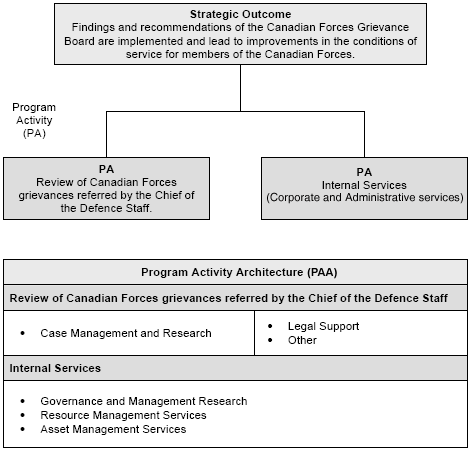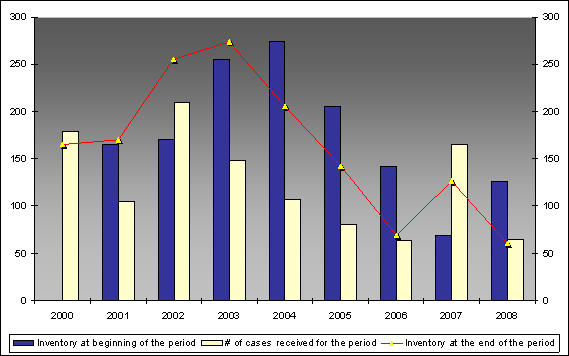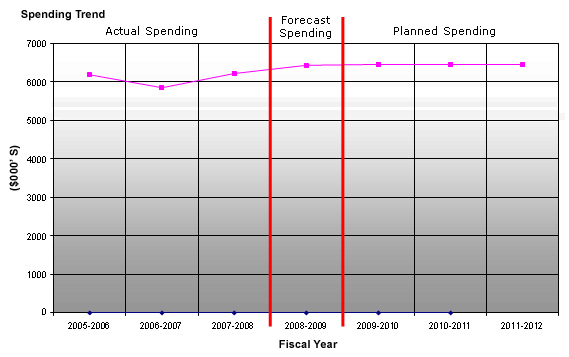Common menu bar links
Breadcrumb Trail
ARCHIVED - Canadian Forces Grievance Board
 This page has been archived.
This page has been archived.
Archived Content
Information identified as archived on the Web is for reference, research or recordkeeping purposes. It has not been altered or updated after the date of archiving. Web pages that are archived on the Web are not subject to the Government of Canada Web Standards. As per the Communications Policy of the Government of Canada, you can request alternate formats on the "Contact Us" page.
Chairperson's Message

I am pleased to submit the Canadian Forces Grievance Board's (CFGB) eighth Departmental Performance Report (DPR) for the period ending March 31, 2009.
Over the last year, the Board delivered on its promise to share with various stakeholders some of the valuable information it gathers while reviewing grievances. The Board launched Perspectives, a newsletter targeted primarily at senior officials at the Department of National Defence (DND) and the Canadian Forces (CF) with the objective of outlining general trends, flawed or inadequate policies, areas of dissatisfaction and problems of a systemic nature. In reporting these issues to the leadership, key decision-makers and professionals associated with conflict resolution in the CF, the Board plays an active role in improving conditions of service for all military personnel.
On the operational side, the Board acted proactively in response to the CF's concerns with regard to the length of time it takes to resolve a grievance from start to finish. As part of the process, the CFGB looked at ways of contributing to reducing overall delays by conducting an in-depth review of its internal processes. The result was an increase in efficiency in the case review process while maintaining the high quality of our Findings and Recommendations.
I am also happy to report that the CFGB made significant progress in the past year to ensure the Board's corporate management is well aligned with the Government of Canada's priorities. Corporate initiatives included expanding the Board's Integrated Business and Human Resources Plan to include an HR three-year strategic plan and a Succession Plan, the development of an Integrated Risk Management Framework, further enhancing the Board's records management system and the expansion of its information management activities to become a more fully integrated Information Management Program.
The CFGB also received a positive Management Accountability Framework (MAF) assessment from the Treasury Board Secretariat for its sound management practices.
The work that we have accomplished in the past year has set the stage for the future. The Board is committed to remain flexible in a changing environment; we will continue, in concert with other stakeholders, to look at ways of making complaint resolution in the CF more efficient and effective. The Board is also preparing to actively participate in the upcoming five-year review of the National Defence Act (NDA). In this environment we will continue to strive to maximize our value-added and fulfill our mission of providing an independent and external review of military grievances to strengthen confidence in, and add to the fairness of, the CF grievance process.
In this, the Board is supported by knowledgeable and experienced Board members and staff, as well as by sound management practices. I am confident that we are well equipped to achieve our newly revised vision of becoming the centre of expertise in military grievances and a model administrative tribunal.
Bruno Hamel
Chairperson
Section I – Overview
1.1 Summary Information
Raison d’�tre
The Grievance Context – The concept of military personnel having the right to grieve and receive redress is not new. However, Canada's introduction, in the year 2000, of the CFGB, a civilian external organization playing a key role in the CF grievance system, represents a major innovation in the handling of military grievances.
Mandate
The Canadian Forces Grievance Board is an independent administrative tribunal reporting to Parliament through the Minister of National Defence.
The Canadian Force Grievance Board reviews military grievances referred to it pursuant to s. 29 of the National Defence Act and provides findings and recommendations to the Chief of the Defence Staff and the member who submitted the grievance.
Responsibilities
As stipulated in the NDA and article 7.13 of the Queen's Regulations and Orders for the Canadian Forces (QR&O), the Board's mandate is to review all military grievances referred to it by the Chief of the Defence Staff (CDS). Following its review, the Board submits its Findings and Recommendations (F&Rs) to the CDS, simultaneously forwarding a copy to the grievor; it is the CDS, however, who is the final authority on all military grievances. The CDS is not bound by the Board's report, but must provide reasons, in writing, in any case where the Board's F&Rs are not accepted.
The Board has quasi-judicial powers and can summon witnesses and compel them to give oral or written evidence. Although hearings would normally be held in private, the Chair can deem a public hearing would benefit the participants and serve the public interest.
QR&O 7.12 sets out the types of grievances that must be referred to the Board. Specifically:
- (1) The Chief of the Defence Staff shall refer to the Grievance Board any grievance relating to the following matters:
- (a) Administrative action resulting in the forfeiture of, or deductions from, pay and allowances, reversion to a lower rank or release from the Canadian Forces;
- (b) Application or interpretation of Canadian Forces policies relating to expression of personal opinions, political activities and candidature for office, civil employment, conflict of interest and post-employment compliance measures, harassment or racist conduct;
- (c) Pay, allowances and other financial benefits; and
- (d) Entitlement to medical care or dental treatment.
- (2) The Chief of the Defence Staff shall refer every grievance concerning a decision or an act of the Chief of the Defence Staff in respect of a particular officer or non-commissioned member to the Grievance Board for its Findings and Recommendations.
Section 29.12 of the NDA stipulates that the CDS may also refer any other grievance to the Board.
Strategic Outcome
In order to effectively pursue its mandate, the Board aims to achieve the following strategic outcome: Findings and recommendations of the Canadian Forces Grievance Board are implemented and lead to improvements in the conditions of service for members of the Canadian Forces.
Program Activity Architecture
The chart at Figure 1 illustrates the CFGB's framework of program activities which contribute to progress toward the Board's Strategic Outcome.
Figure 1

1.2 Summary of Performance
| Planned Spending | Total Authorities | Actual Spending |
|---|---|---|
| 6,436.0 | 6,979.0 | 6,035.0 |
At the outset of the 2008-09 fiscal year, the Board's planned spending was $6.4 million. Through Main Estimates and Supplementary Estimates, the Board was allocated total authorities of $6.9 million. Actual spending for the CFGB was $6.0 million.
| Planned | Actual | Difference |
|---|---|---|
| 46 | 38 | (8) |
The variance in Full-time Equivalents (FTEs) from 46 to 38 is primarily due to delays in staffing of positions.
| Strategic Outcome: Findings and Recommendations of the Canadian Forces Grievance Board are implemented and lead to improved conditions of service for members of the Canadian Forces. | ||
|---|---|---|
| Performance Indicators | Targets | 2008-09 Performance |
| The percentage of systemic recommendations that merit further study. | 75% of recommendations that merit further study are accepted by the CDS. |
Out of the 124 decisions from the CDS received during the period, 23 cases presented 25 systemic recommendations for further study and the CDS accepted 72%. During the reporting period systemic recommendations related to problems with procedural fairness; additional training on Cadet Harassment and Abuse Prevention process; quality of provided information specifically in publications related to pension plans and release pay benefits. |
| The percentage of the Chief of the Defence Staff agreement with the Board's recommendations regarding the interpretation and application of regulations, policies and guidelines. | 80% agreement |
Out of the 124 decisions from the CDS received during the period, 20 of the 25 systemic recommendations dealt with interpretation and application of regulations, policies and guidelines. The CDS was in agreement in 70% of those recommendations. During the reporting period major trends were reflected in a number of grievances: inconsistencies between regulation and policy and errors stemming from the administration of the enrolment process. |
| The percentage of survey respondents indicating that the Board has contributed to changes to CF regulations, policies and procedures. | 70% agreement | Success regarding this performance indicator will be assessed through formal evaluations every 5 years. The next evaluation will be conducted in 2009-10. |
| Program Activity | 2007-08 Actual Spending |
2008-09 | Alignment to Government of Canada Outcomes | |||
|---|---|---|---|---|---|---|
| Main Estimates |
Planned Spending |
Total Authorities |
Actual Spending |
|||
| Review of Canadian Forces grievances referred by the Chief of the Defence Staff | 3,325.2 | 3,354.0 | 3,354.0 | 3,336.0 | 3,059.0 | |
| Internal Services | 2,896.8 | 3,082.0 | 3,082.0 | 3,643.0 | 2,976.0 | |
| Total | 6,222.0 | 6,436.0 | 6,436.0 | 6,979.0 | 6,035.0 | |
Contribution of Priorities to Strategic Outcomes
| Operational Priorities | Type | Status | Links to Strategic Outcome(s) |
|---|---|---|---|
|
Productivity Strengthened performance through monitoring its Performance Measurement Strategy and by seeing that its timeline standards are met. |
Ongoing |
Not met 21% of cases met the standard of 6 months review while 51.3% were slightly over averaging a 9 months review. During the period of this report, the Board completed cases for which the review had mainly been done under a different process which increased the time the case spent at the Board. The expectation was that the introduction of additional steps to the Board's internal process would reduce the overall completion time of grievances at the final authority level. While the pilot project ended during the reporting period, a number of cases completed during this reporting period had been part of the pilot project. The Board conducted an in-depth study with the aim of improving its internal file review process and the Board regained the desired level of efficiency. In some cases, the new process also yielded an additional benefit by facilitating withdrawals and informal resolutions much earlier in the process than was previously the case. |
Strategic Outcome (PA) Review of Canadian Forces grievances referred by the Chief of the Defence Staff |
|
Improving the CF grievance system Contributed to improving the system by sharing lessons learned with stakeholders/partners involved in the military grievance system. |
Previously committed to |
Successfully met The Board disseminated information on the impact of its work by launching a newsletter targeted primarily at senior CF officials at the Department of National Defence (DND) Headquarters. |
Strategic Outcome (PA) Review of Canadian Forces grievances referred by the Chief of the Defence Staff |
|
External communications Reached out to CF members and other stakeholders to build awareness of the Board's mandate and foster an understanding of the service it provides, as well as the impact of its work and its value-added. |
Ongoing |
Successfully met The Board published an insert in the Maple Leaf, the weekly national newspaper of DND and the CF, which included information about the Board and summaries of cases reviewed by the Board. |
Strategic Outcome (PA) Review of Canadian Forces grievances referred by the Chief of the Defence Staff |
| Management Priorities | Type | Status | Links to Strategic Outcome(s) |
|
Excellence in Management The continued co-ordination of a strong governance and accountability framework to ensure that the Board remains focused on results. |
Ongoing |
Successfully met Enhanced capacity to collect and use performance information for informed decision making at all levels. Improved integration of the risks the Board faces, and how best to mitigate them within the Board's processes. |
Strategic Outcome (PA) Internal Services |
|
Public Service Renewal Improving the integration of business planning with human resources (HR) planning to respond to changing demographics, projected labour shortages, effective labour relations and evolving learning needs. |
Previously committed to |
Successfully met Improved integration of business and HR plans. Put in place specific measures regarding recruitment to achieve representation of designated groups according to workforce availability. Identified the development of leadership competencies as a priority and in 2008-09 leadership courses provided by the Canada School of Public Service (CSPS) were offered to all executives and feeder groups. Enabled employees to plan their careers and develop learning plans that addressed the gaps in their skills and knowledge. Provided employees with training and learning opportunities to ensure the attainment of the Board's strategic business and corporate goals. All executives have clear, assessable on-going and key commitments. The revised Performance Management Program was implemented in the first quarter of 2008-09 for all eligible excluded or unrepresented employees and the Board expanded the more rigorous system to include all Executive Group (EX) feeder groups. Services standards for pay, staffing and classification are established. |
Strategic Outcome (PA) Internal Services |
|
Values and Ethics Highlight the importance of public service values as the foundation of ethical behaviour. |
Ongoing |
Successfully met The Board launched its five-year action plan to promote Public Service Values and Ethics within the Board. |
Strategic Outcome (PA) Internal Services |
Risk Analysis
Some key factors beyond the direct control of the Board can influence the realisation of its main objectives. One significant factor is that the Board has no control over the number of grievances referred in any given year. Significant fluctuations will have an impact on the financial and human resources planned by the Board to ensure that F&Rs are issued in a timely basis. To mitigate this risk, the Board monitors workload planning assumptions on an ongoing basis. Workload planning assumptions provide the basis for establishing the correct number and mix of staff to meet the objectives of providing a timely review of grievances, consistent with the Board's production standards.
The Board focussed on achieving efficiency in the grievance review process to reach a steady-state of operations where the completion rate of a 1-1 ratio could be attained. From 2000 to 2004, the CFGB based its planning assumptions on an estimated referral of 120 to 140 cases per year; since then there has been a decline where it is expected that an average of 75 to 90 cases will be referred per year. Consultations with the Director General Canadian Forces Grievance Authority (DGCFGA), whose role is to oversee the administration of the CF grievance system, indicate that there has been a trend showing a decline in the number of grievances from 350 to 250 at the Final Authority (FA) level in the system overall. Figure 2 demonstrates the decline of cases referred and the state of the inventory over the years.
Figure 2

Under the current system, the Board reviews approximately 40% of grievances at the FA level. Discussions within the CF are presently taking place with regard to further streamlining the CF grievance system as a whole. The streamlined process may include changes to the Board's own grievance review process as a different model may be adopted for the referral of grievances to the Board in order to maximize its resources.
The Board also responded to another concern related to the duplication and sometime overlap with the many CF resolution processes available to grievors. A trial is underway of a new "principled approach" to grievance referral founded on the value-added the Board review could bring to the resolution of grievances. Under this approach the Board would review all grievances for which the CF was unable to find a resolution mutually accepted by all parties. This approach is being discussed within the CF and is generally supported by senior officials.
As well, the Board faces several key HR and information management and informatics challenges. Some of these challenges, common to the Public Service, include changing demographics, projected labour shortages, effective labour relations and evolving learning needs. To ensure that the Board meets these challenges and to strengthen its human resources management, the Board has developed an HR three-year strategic plan and a Succession Plan. As well, the Board has made it a management priority to ensure that the integrity and completeness of information within the organization is not compromised or lost.
Expenditure Profile
CFGB's actual spending for 2008-09 was $ 6.0 million. Over the past three years actual spending has increased by 3% from 2006-07 levels. This increase was primarily due to collective bargaining agreements. The chart at Figure 3 shows the Board's spending trend over a six-year period (three-year actual spending and three-year planned spending)
Figure 3

Voted and Statutory Items
This table illustrates the voted items Parliament approved through the Main Estimates. The statutory items are displayed for information purposes only.
| Vote # or Statutory Item (S) | Truncated Vote or Statutory Wording | 2006-07 Actual Spending |
2007-08 Actual Spending |
2008-09 Main Estimates |
2008-09 Actual Spending |
|---|---|---|---|---|---|
| 15 | Operating expenditures | 5,288.2 | 5,605.0 | 5,864.0 | 5,490.0 |
| (S) | Contributions to employee benefit plans | 563.8 | 617.0 | 572.0 | 545.0 |
| Total | 5,820.0 | 6,222.0 | 6,436.0 | 6,035.0 | |
